21 Winter Steelhead Fishing Tips And Tactics Of Experts
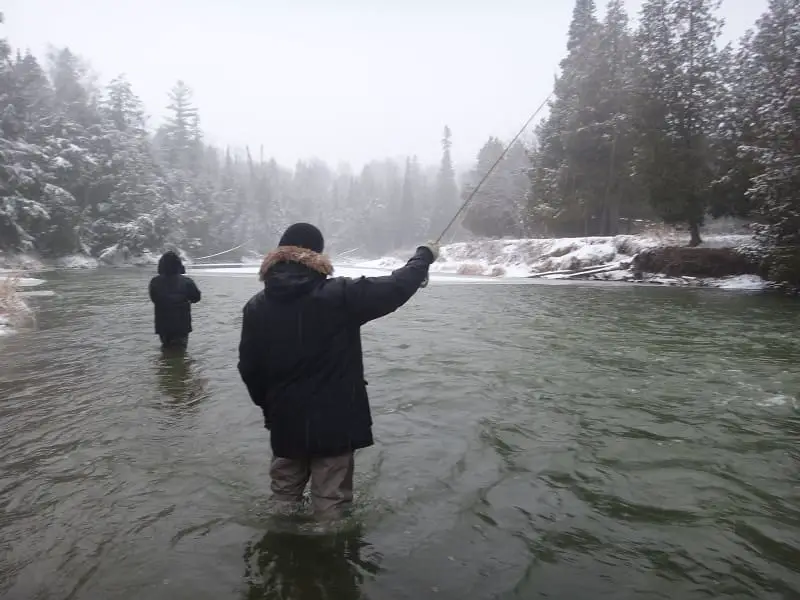
Fishing for steelhead in the winter can be tough for many anglers, but I fish and guide for steelhead all winter and we catch a lot of steelhead.
If you want to start catching winter steelhead consistently, then these are my guide tips and tactics that I and other guides use to keep our clients catching steelhead all winter.
It’s possible to catch lots of steelhead all winter by understanding the fish itself which includes migration and holding patterns, and how temperatures affect steelhead.
It’s also critical to know what methods to use, what baits work for steelhead in the winter, and use the setups that we have proven to catch steelhead anywhere around the great lakes region during the winter.
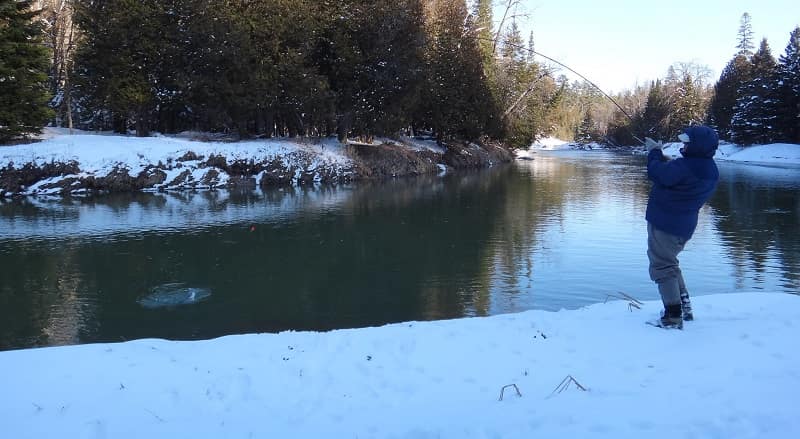
Winter steelhead fishing starts when the water temperatures get close to freezing, and the air temperatures are close to or below freezing most days.
I tell my clients we are in winter conditions when I start to see ice forming at the edges of the river. I know this is when the water is very cold, and the steelhead will start reacting accordingly.
Winter fishing means cold hands, cold feet, and ice in the rod guides, and it’s also when the steelhead can get harder to catch for many anglers.
This is what you need to know about fishing for steelhead in the winter if you want to consistently catch steelhead, like steelhead guides do.
1. Water Temperature Matters
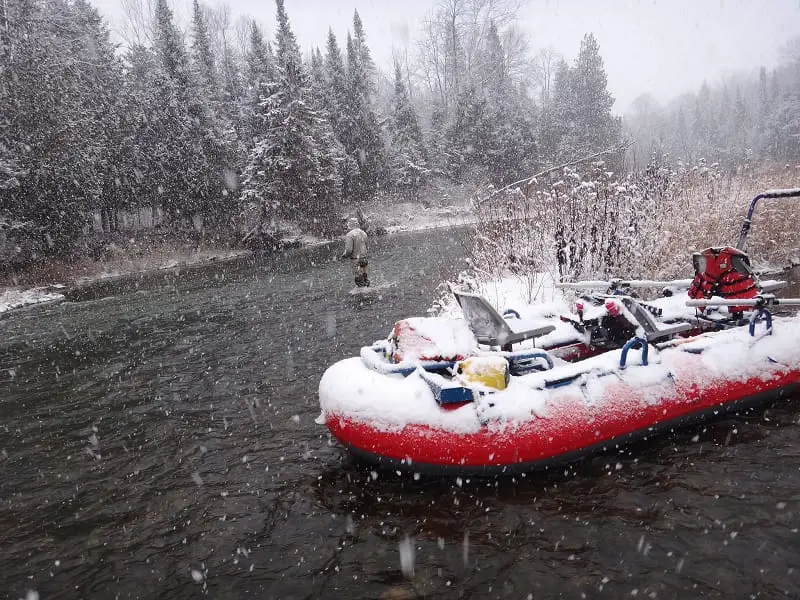
Do not listen to anglers who say you can’t catch steelhead when the water hits a certain temperature: that is BS!
Steelhead are temperature sensitive, but they can still be caught at a very cold temperatures that are just above freezing.
The temperature itself does not matter. What matters and what you need to know is that steelhead will feed during the winter when water temps are stable or rising, and they won’t feed when the water temps are dropping.
This is why on a day in late November when the water temps are dropping and are 43F, it’s hard to catch fish, but in January, on a warmer sunny day when the water temps are 36 and rising, I can catch a ton of steelhead.
2. Location: Where Steelhead Hold In The Winter
Steelhead will hold in the deeper slower water sections of the river throughout the winter.
If they can avoid faster water and shallow water, they will. Focus on the deeper middle and tail-out section of the pools, and you will do much better.
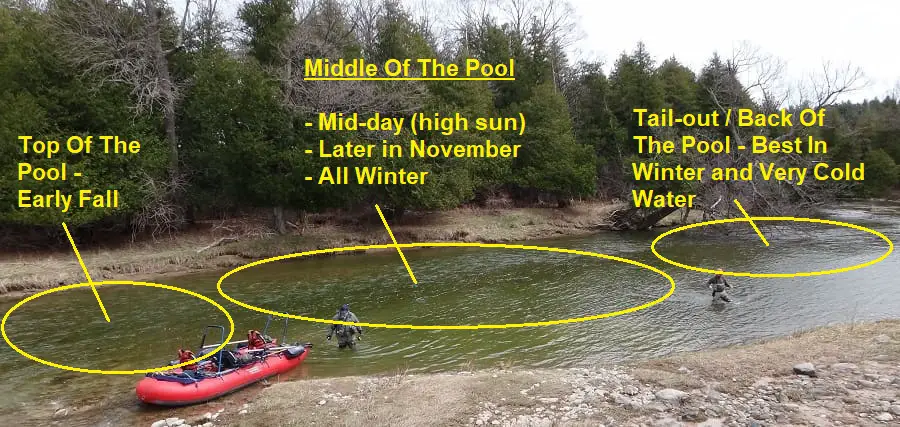
Early in October, I catch 90% of the steelhead in the top part or head of the pool and in faster shallow water rapids and pockets because the steelhead at this time of year are on the move in the warmer water.
Steelhead migration patterns in winter will change, therefore you should learn to adapt if you want to catch more fish.
3. Best Winter Baits
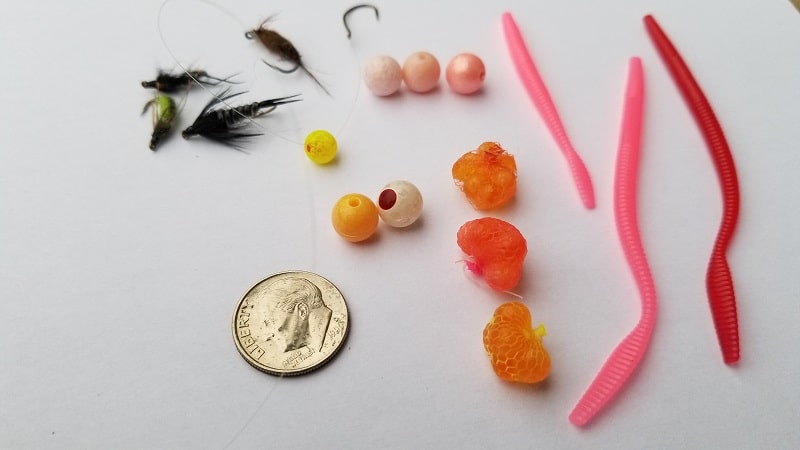
Any bait can work in the winter. But, the rivers are often extra clear in the winter, so I often start with smaller baits, and if they do not work, I will start upsizing.
I will also start with more natural colors, and if they do not work, I will try brighter colors. You should always have an assortment of baits that you can rotate through.
Good baits to try in the winter are:
- Spawn Bags
- Single Salmon Eggs
- Beads
- Worms: Live and plastic worms in pink and red are my go-to colors.
- Minnows: or local baitfish
- Artificial flies
4. Focus On Predictable Feeding Times
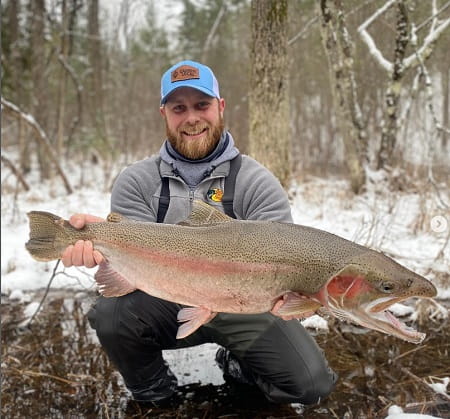
I have learned that the best time to fish in the winter is after the sun has stabilized water temps or even warmed up the river a degree or two.
My most productive times are from 11 am to 3 pm.
We all know it gets colder outside at night. Well, so does the water. The water temps drop at night, and in the morning, they are often as cold as they are going to get.
5. Keeping Warm In Winter
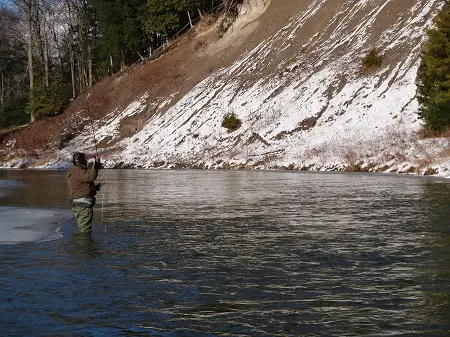
I have learned as a guide that everyone’s feet freeze and that standing in the water or on the bank for hours makes you very cold. I tell my clients what to bring and what to wear, but many still freeze.
Some of my best tips for staying warm are:
- Bring an extra set of gloves.
- Use disposable hand warmers.
- Wear a thick hat made of wool or other insulating material.
- Where a thin base layer sock and a thick sock that is made of merino wool or another insulating material.
- Where boots that are 1 to 3 times too big to allow air circulation and prevent compression on your feet from the extra socks.
- Wear a thin base layer, a middle insulated base layer, and a thick thermal layer. Then, wear your outer layer, which is either a wading jacket or a winter coat.
- Move a lot. If your feet, hands, or body starts to get cold, walk to the next spot or a spat far away to increase body temperatures. This helps a lot.
6. Pick Your Fishing Days Wisely
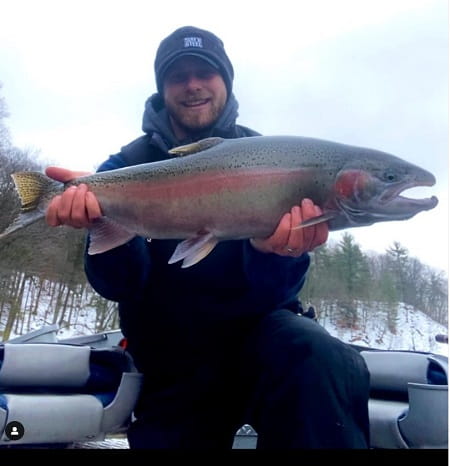
Be smart about fishing in the winter. If the temperature is dropping throughout the day, stay home.
Sunny days with warming temps can be the best days.
Warm spells that last a few days or more can be some of the best steelhead fishing of the year.
7. Less Crowds Equal More Fish
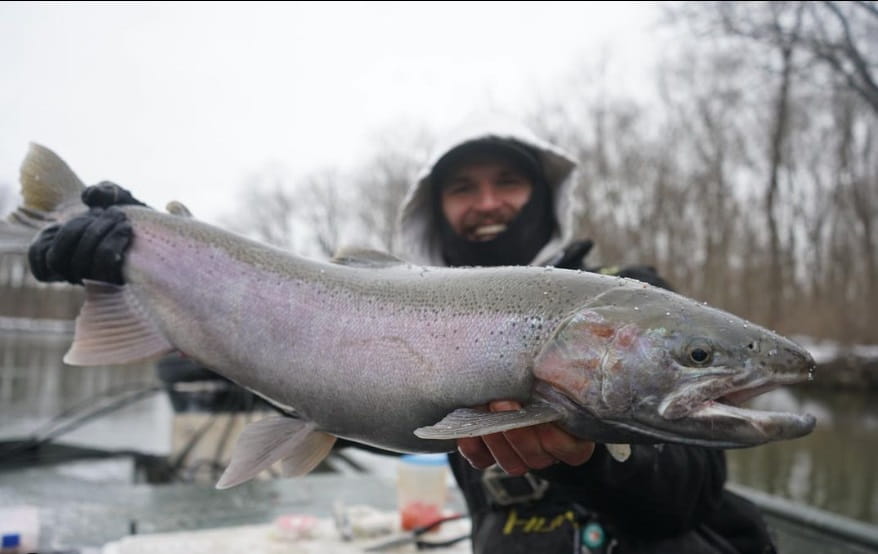
Winter is a great time to be on the water because there are fewer anglers on the river, and there are often more and bigger steelhead in the river.
For me, the winter is also when my clients are having the most 15 to 20+ fish days.
Winter fishing for steelhead extends to about the end of February, which is often when the snow starts melting, and is when the big spring steelhead runs start. This is also when I see the gradual warming of the river.
8. Can You Fish For Steelhead In The Winter?
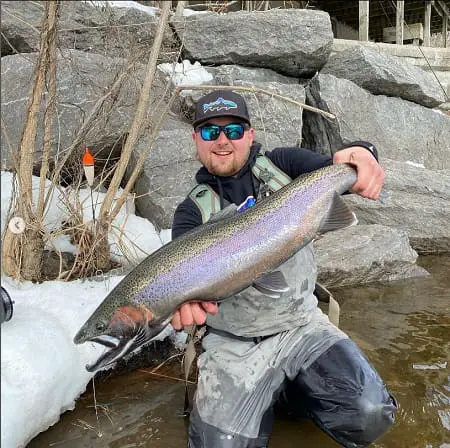
You can fish for steelhead in the winter as long as the fishing rules and regulations in your area permit you to legally fish for steelhead at this time of year, and also provided that the river is not frozen solid.
9. Adapt To Water Conditions
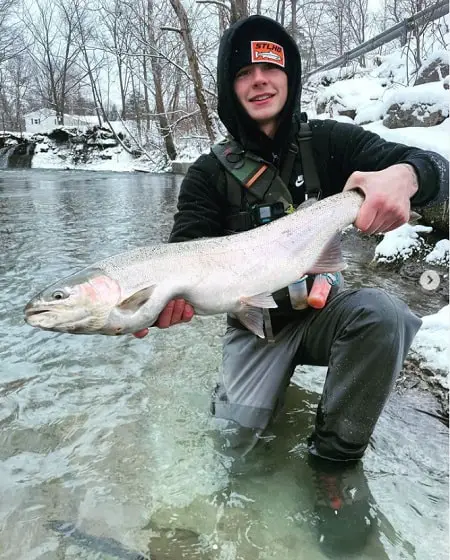
Slush on the water is an indication that the river is getting colder and is starting to freeze, and this is often not a good time to fish.
But if later in the day you notice that the slush is less or has disappeared, the river is warming, and the steelhead can start to become active.
GUIDE TIP: If you are going to winter fish for steelhead and you want to catch the most fish possible, sleep in and start fishing later in the morning, the sluch will be less then too.
10. Break The Ice For More Steelhead
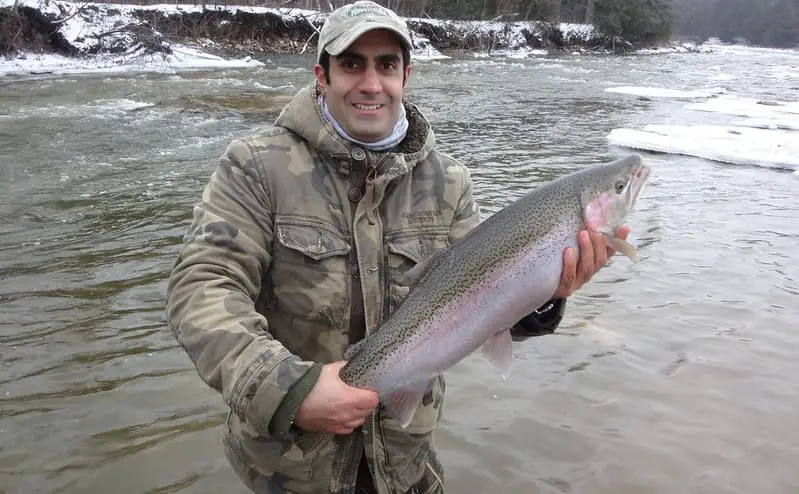
GUIDE TIP: If you arrive at a spot there is a lot of shelf ice or thin ice, break it out! I use my foot to break out shelf ice. I have buddies who have a car tire rim attached to a rope that they throw out to break the edges or to break thin ice. I’ve seen them open an almost completely ice-covered pool and then catch a ton of steelhead.
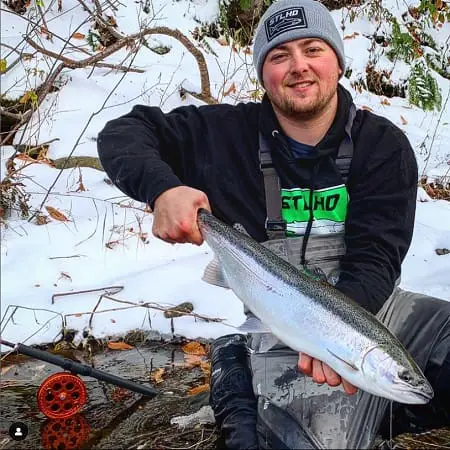
Although most anglers would think all of the noise of breaking ice would spook the fish, I have done this many times and have caught plenty of fishing immediately afterward.
So, don’t be afraid to break the ice out, especially if it is impeding your ability to fish. Just be sure you do it safely.
11. Lure Fishing Cold Water Steelhead: Slow It Down
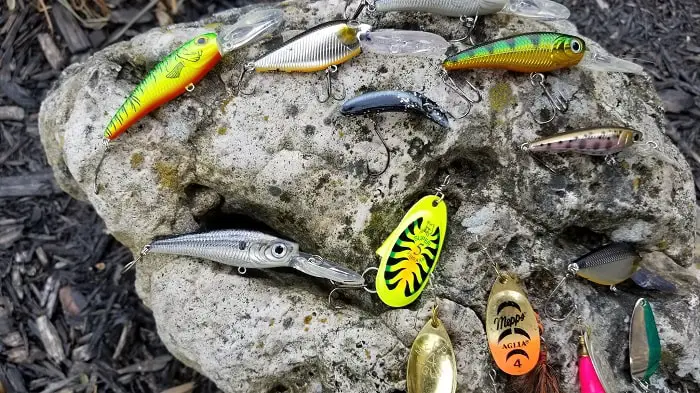
Anglers can lure fish for steelhead, and I have found that if you slow your presentation down and if you downsize your lure size, some of the more aggressive steelhead will chase and bite your lure.
Slow moving lures like the Kwickfish are often best.
Learn more about the best lures for steelhead and how I fish them on my page Best Steelhead Lures
13. Float Fishing For Cold Water Steelhead
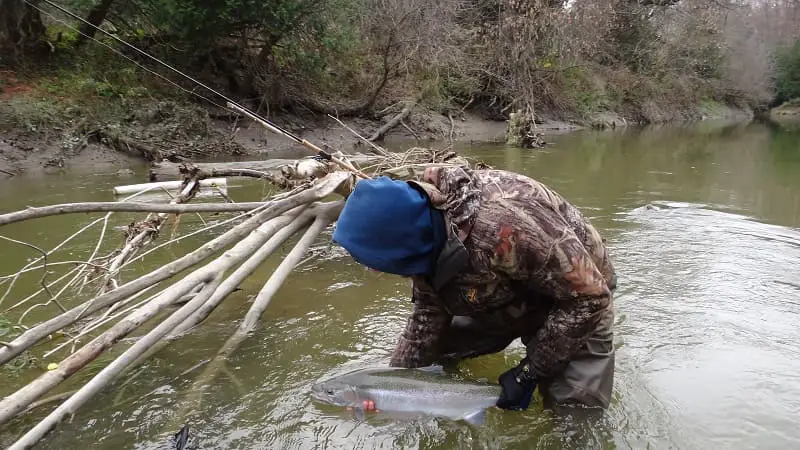
Float fishing is probably the most effective method to catch steelhead in icy waters. With float fishing, you can slow your presentation down and target both the neutral and the more aggressive steelhead.
Learn more about how to float fish effectively, including my leader setup, the right floats, gear, and how to float fish better.
14. Fly Fishing For Steelhead In The Winter
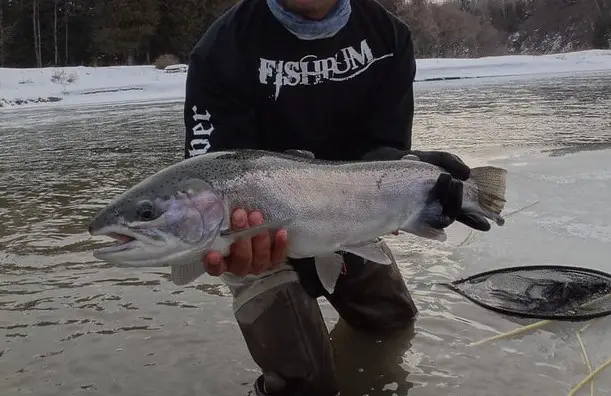
Fly fishing is a method I use to fish for steelhead in the winter, and it’s often my favorite method.
The downside to fly fishing for steelhead in the winter is cold and wet hands.
Stripping in the fly line makes your hands wet, and this can become a problem with fingers that are so cold they hurt.
Aside from this, fly fishing for steelhead in the winter can be effective, and there are things that I do that prevent my hands from getting wet and cold.
Click to learn more and to see how and what I use to fly fish for steelhead in the winter.
Other methods used to catch wintertime steelhead are:
16. Use Spawn
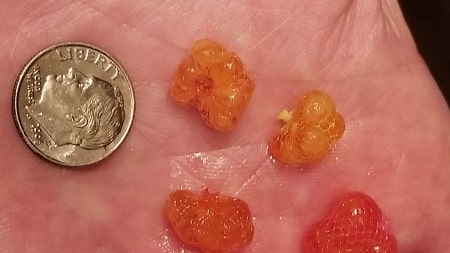
Spawn is one of my most effective baits during the winter. Just be sure you have an assortment of sizes and colors.
17. Worms For Steelhead In Winter?
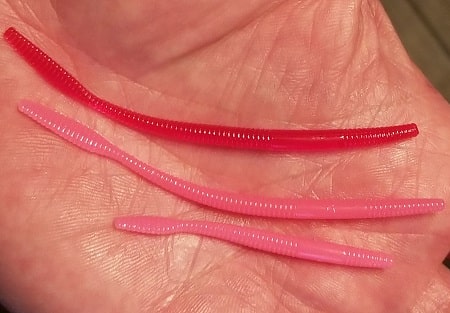
If I had to guess, I would say that over 50% of the fish my clients catch during the winter are caught on pink worms.
Red worms also work, and so do live worms.
18. Beads Are Excellent For Winter Steelhead
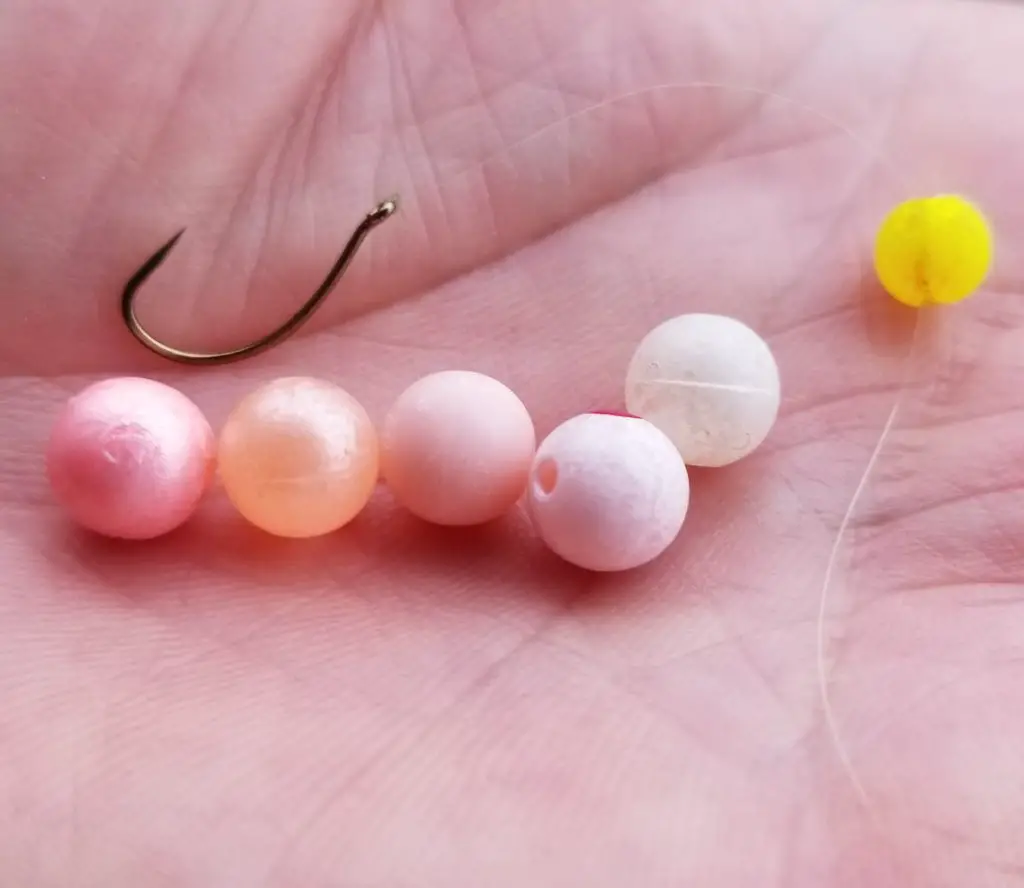
When fishing for steelhead in the winter, I like to use light-colored beads because the loose salmon eggs from the fall that drift down with the current will be yellowish or white at this time of year.
Bead colors like white, peach, light pink, and light orange can be fantastic colors in the winter.
You can use beads in both soft beads or hard beads and there are a variety of brands that I have found to be effective.
19. Single Eggs Are Deadly For Steelhead In The Winter
Single eggs are just that, one single salmon egg on a hook.
Whether you cure them yourself or buy them, single eggs are small and can be one of the best baits to entice holding steelhead to bite.
It’s not uncommon to see one of my guides and his clients catching a lot of steelhead on single eggs when other anglers around them aren’t catching anything.
20. Winter Steelhead Flies
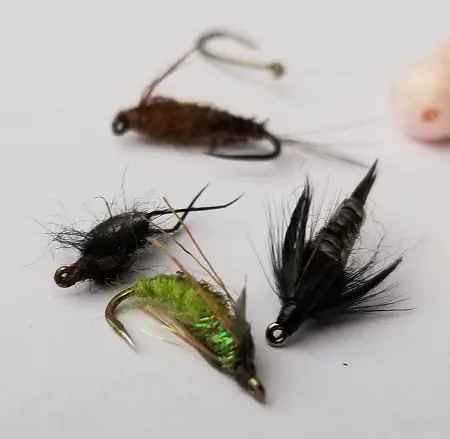
In the winter, flies can often be my best bait for steelhead.
The reason for this is that during the winter, often the only abundant natural food source for steelhead that are holding in the river is aquatic insects.
21. Use These Methods That Pro River Guides Use To Stay Warm And Dry
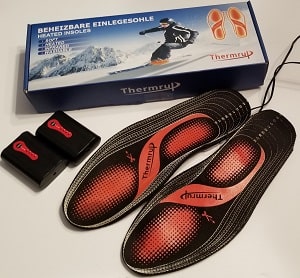
Layering and using the right gear is the key to keeping yourself warm, but there are some other tricks that work great, like heated insoles and certain types of waders.
I discuss all of my best winter fishing gear and the tips and tricks on my page Fishing In The Winter – Stay Warm With These 10 Tips.
Additional Tips
- Fish Slow – Fish your fly slow and your bait slow.
- Keep Your Hooks Sharpe
- Wade Out – Wade out only as far as you need to in order to get a good presentation.
More On Steelheading In Winter
You have just read the edited and short version of this article. If you want more information tips, tactics, and more in-depth information on how to catch more steelhead in the winter, check out the full article HERE.
If you have a tip, an idea, or a question about winter fishing for steelhead, let me and other readers know in the comments section below.
Tight Lines,
Graham
References:
Steelhead Study Results in Several Interesting Conclusions | U.S. Fish & Wildlife Service (fws.gov)
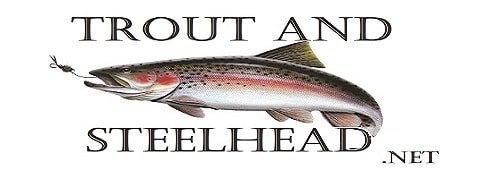
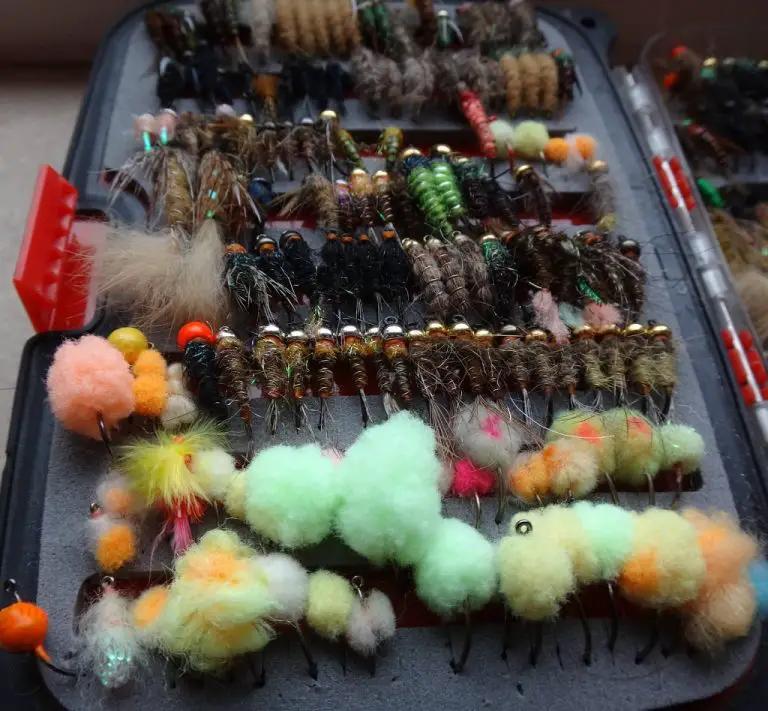
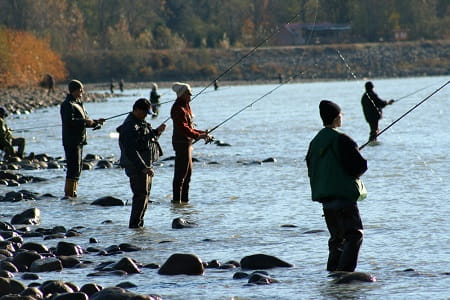

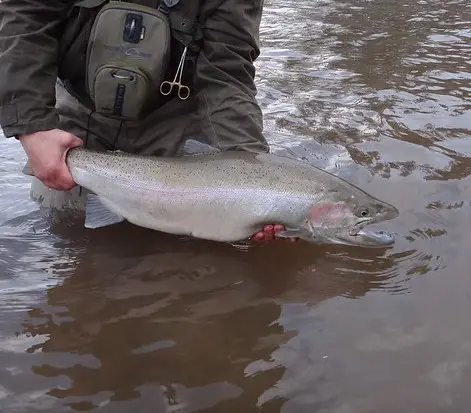
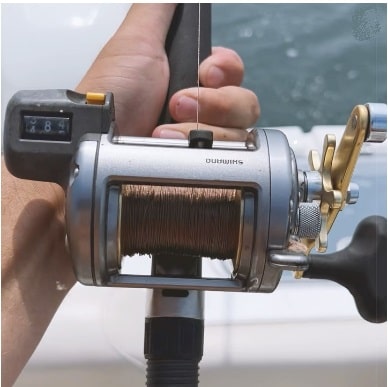
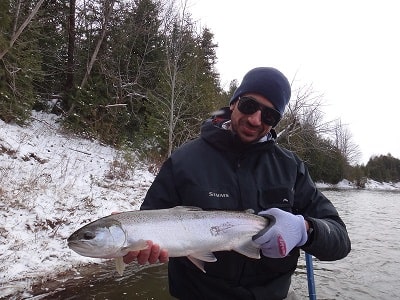
Great read
I fish in medium sized river in MI where the holes are 9-15 ft deep. In these deep holes would you drift fish or float fish and what baits would be good in the winter for deeper holes. I would drop to a 6mm or 8mm bead in winter but with a 15’ hole do I size back up to 10mm. What size jig? Or maybe worm better
It would depend on the current which method I would recommend. In slow to faster currents, float fishing generally always works well, even in the deeper water as long as you have the proper setup.
Drift fishing can also work in faster deeper currents but I would avoid it in slower water.
I would adjust my bait size, color, and type of bait based on what the fish want, not on how deep the water is. Just because it’s deeper water doesn’t mean they will want to eat a larger bait or smaller bait. If an 8mm bead works in 5 feet of water, the chances are good it will work in the deeper water to.
I’m working on a series of articles with the cooperation of a few Michigan river guides. You may find some valuable info there. Check out Steelhead Fishing Michigan.
Graham
I would like to book a trip I live close to cincinnati Ohio Not sure where your located and what’s available ASAP
Hi Mike, Although I have fished most of the rivers in northeast Ohio I do not guide that area. You should consider contacting the guys at Steelhead Alley Outfitters. Good luck.
How would you describe the difference between spinner water and spoon water?
Hi Ward,
There is no difference to me. I can fish spinners and spoons in all the same water, whether that be fast, slow, shallow, or deep water. You just need to know how to adapt to the different water by using different sizes or weights of each lure and different retrieves that work in the type of water you are in.
Sink time as well and changing your retrieve angles, your speeds, and your rod tip position to adjust to the type of water and to get your bait at the right depth and moving in a way that the fish will react to it.
The key is to know how to adapt and how each lure works in the water you are fishing. That takes time and practice.
Good luck.
Hi Graham, am an avid Steelheader in British Columbia, Canada and really appreciate the Excellent content that you share on your website!! One thing I haven’t seen and hoping you can write about is catching Steelhead in Sunny conditions?? Right or wrong, seem to be much less successful on Bright Sunny days… ? Thanks again! Cheers, Edwin
Hey Edwin,
Yes, High sun conditions can be very tough but due to the water temperature increase during the winter I have a lot more success mid-day on high sun days. I would focus more on the deeper pools where the sunlight penetration is least, or try and find shaded areas.
Otherwise, when the fish are off due to the high sun there is not much you can do except wait until the sun is lower in the sky.
Good Luck,
Graham
Love the articals
Wow! Thanks for this treasure trove of work. Contrary to my school of thought I really need to scale down my winter Steelhead presentations. Looking at the diamater of my chosen 10 lb & 8 lb leader diameters is a real eye opener. I hope I can pull it all together on the river soon.
In Pa . I see guys fishing very effectively with plastic minnow jig combinations . Their rods are very wimpy tipped and allow the angler to twitch the minnow jigs in the pool. I cannot duplicate that twitchness with my rod. Who makes these wimpy tipped steelhead rods?
Hey Marty,
I’ve seen that method used all around the great lakes.
Most steelhead rods are moderate action with stiffness spread out throughout the blank to allow for the impact from fast runs and leaps of steelhead and to protect light leaders.
If you want a soft tip rod you might want to look for a fast or extra fast action jigging rod around 7 to 9 feet and designed for jigging. The three jigging rods I’ve used and recommended are listed on my page Jig Fishing For Steelhead.
The other option is if you see someone jigging, ask them what rod they are using, I’ve found that most guys are open to talking and are helpful, especially if you don’t stomp into the pool like a herd of buffalo.
Good Luck,
Graham
When are best times and best locations for winter steelhead on a boat in British Columbia or Vancouver Island?
Hi Stephen,
It depends on the river system but in general, the runs start in November, peak in December and continue through the winter into late April.
Good luck,
Graham
Thank you for your blog….Your articles are the best collection of information I have seen. You really should publish a book.
Happy to help 🙂